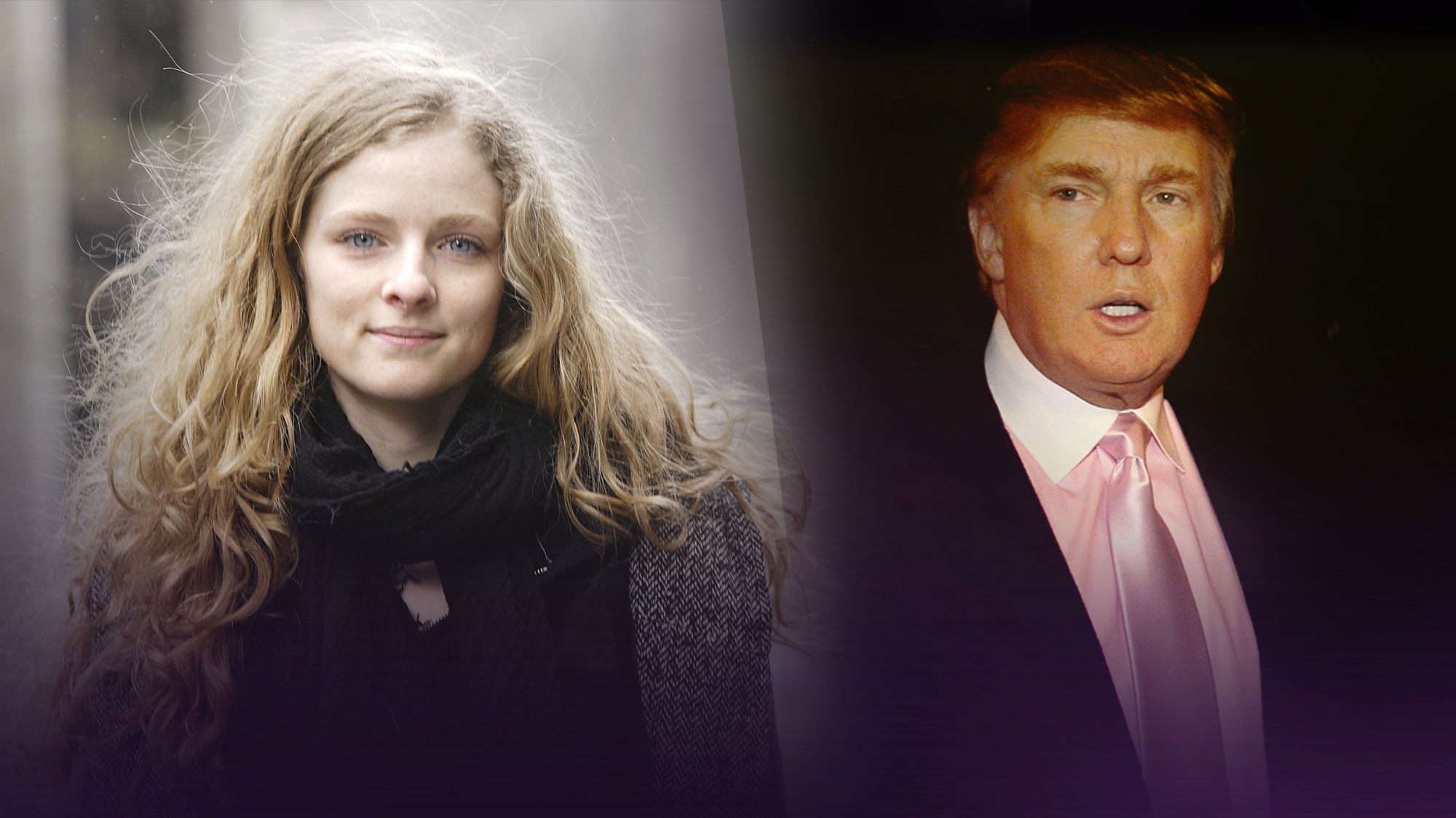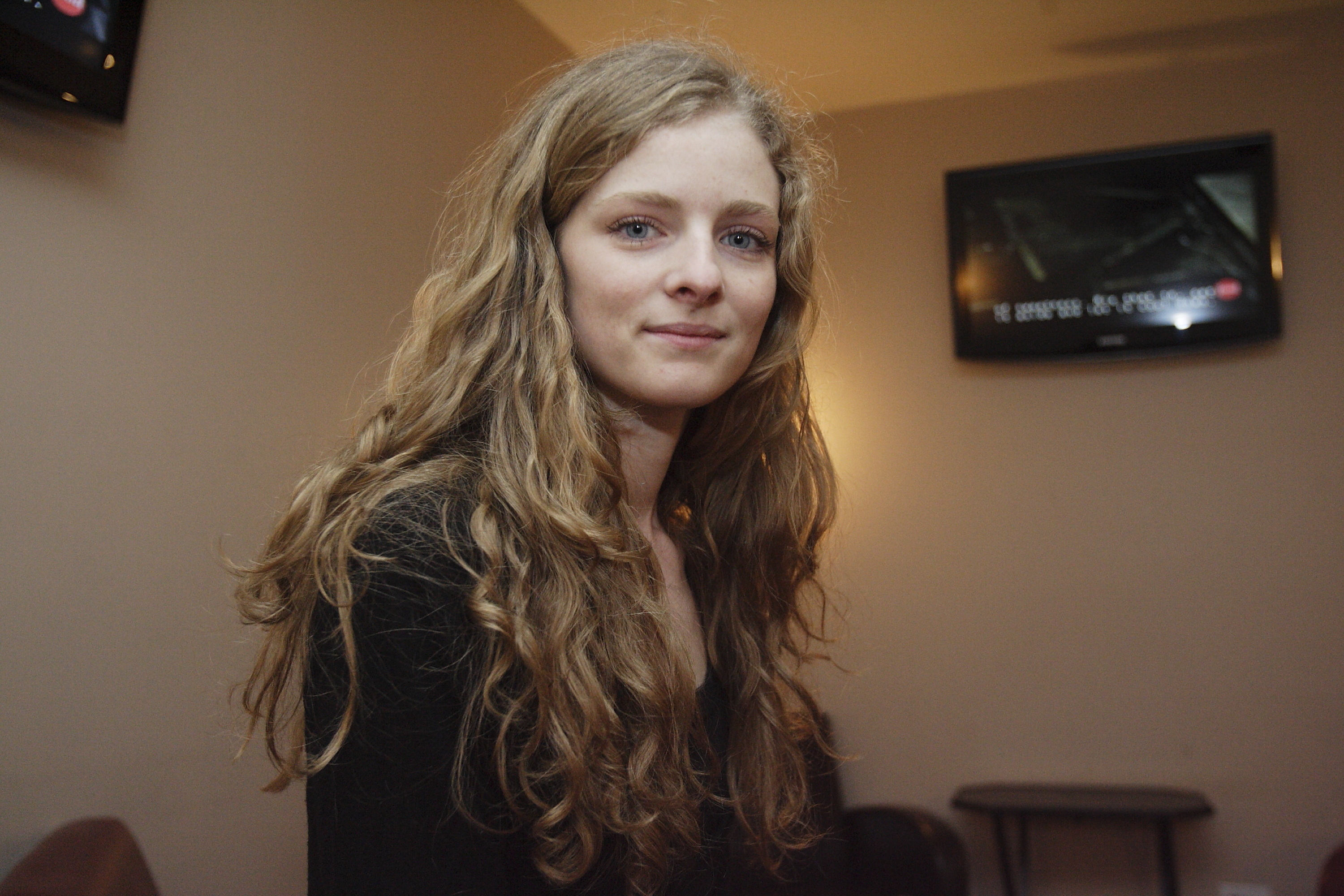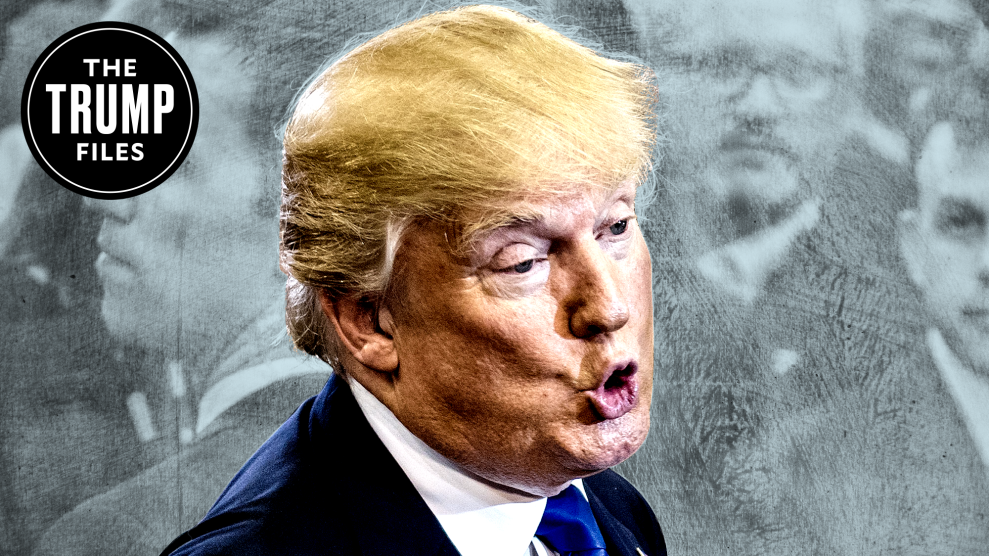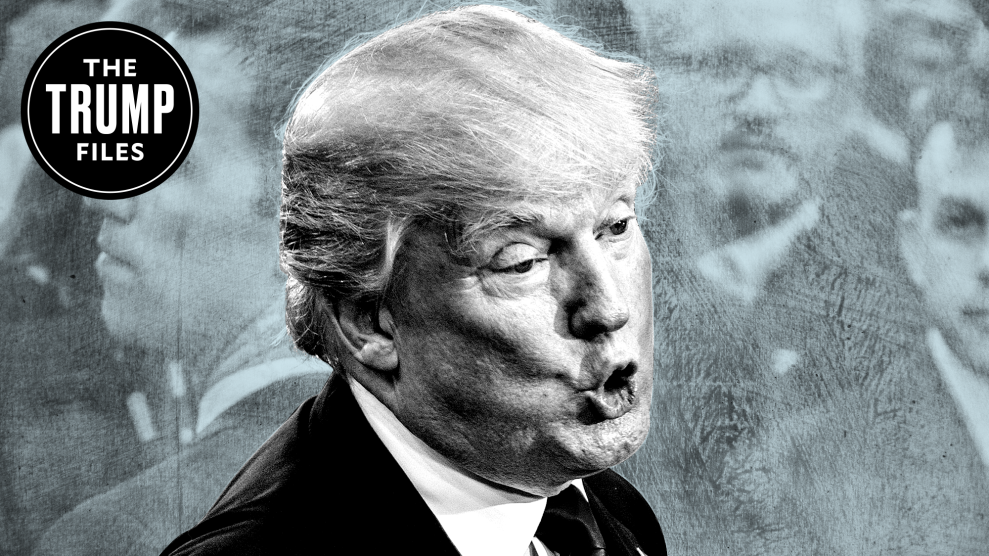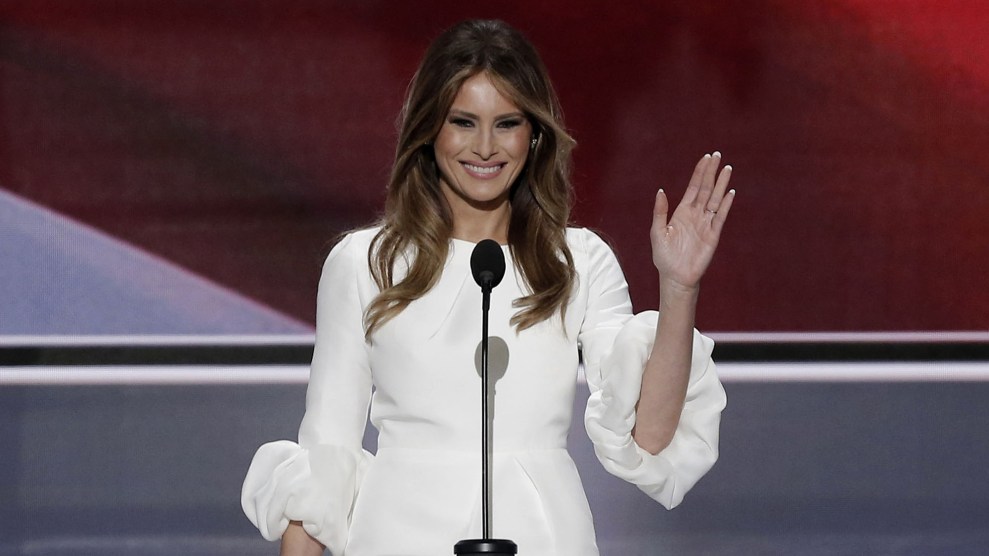Republican nominee Donald Trump has placed immigration at the core of his presidential campaign. He has claimed that undocumented immigrants are “taking our jobs” and “taking our money,” pledged to deport them en masse, and vowed to build a wall on the Mexican border. At one point he demanded a ban on Muslims entering the country. Speaking to supporters in Iowa on Saturday, Trump said he would crack down on visitors to the United States who overstay their visas and declared that when any American citizen “loses their job to an illegal immigrant, the rights of that American citizen have been violated.” And he is scheduled to give a major address on immigration in Arizona on Wednesday night.
But the mogul’s New York modeling agency, Trump Model Management, has profited from using foreign models who came to the United States on tourist visas that did not permit them to work here, according to three former Trump models, all noncitizens, who shared their stories with Mother Jones. Financial and immigration records included in a recent lawsuit filed by a fourth former Trump model show that she, too, worked for Trump’s agency in the United States without a proper visa.
Foreigners who visit the United States as tourists are generally not permitted to engage in any sort of employment unless they obtain a special visa, a process that typically entails an employer applying for approval on behalf of a prospective employee. Employers risk fines and possible criminal charges for using undocumented labor.
Founded in 1999, Trump Model Management “has risen to the top of the fashion market,” boasts the Trump Organization’s website, and has a name “that symbolizes success.” According to a financial disclosure filed by his campaign in May, Donald Trump earned nearly $2 million from the company, in which he holds an 85 percent stake. Meanwhile, some former Trump models say they barely made any money working for the agency because of the high fees for rent and other expenses that were charged by the company.
Canadian-born Rachel Blais spent nearly three years working for Trump Model Management. After first signing with the agency in March 2004, she said, she performed a series of modeling gigs for Trump’s company in the United States without a work visa. At Mother Jones‘ request, Blais provided a detailed financial statement from Trump Model Management and a letter from an immigration lawyer who, in the fall of 2004, eventually secured a visa that would permit her to work legally in the United States. These records show a six-month gap between when she began working in the United States and when she was granted a work visa. During that time, Blais appeared on Trump’s hit reality TV show, The Apprentice, modeling outfits designed by his business protégés. As Blais walked the runway, Donald Trump looked on from the front row.
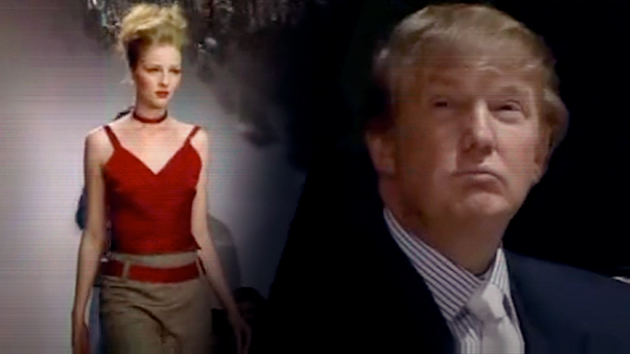
Two other former Trump models—who requested anonymity to speak freely about their experiences, and who we are giving the pseudonyms Anna and Kate—said the agency never obtained work visas on their behalf, even as they performed modeling assignments in the United States. (They provided photographs from some of these jobs, and Mother Jones confirmed with the photographers or stylists that these shoots occurred in the United States.)
Each of the three former Trump models said she arrived in New York with dreams of making it big in one of the world’s most competitive fashion markets. But without work visas, they lived in constant fear of getting caught. “I was pretty on edge most of the time I was there,” Anna said of the three months in 2009 she spent in New York working for Trump’s agency.
“I was there illegally,” she said. “A sitting duck.”
According to three immigration lawyers consulted by Mother Jones, even unpaid employment is against the law for foreign nationals who do not have a work visa. “If the US company is benefiting from that person, that’s work,” explained Anastasia Tonello, global head of the US immigration team at Laura Devine Attorneys in New York. These rules for immigrants are in place to “protect them from being exploited,” she said. “That US company shouldn’t be making money off you.”
Two of the former Trump models said Trump’s agency encouraged them to deceive customs officials about why they were visiting the United States and told them to lie on customs forms about where they intended to live. Anna said she received a specific instruction from a Trump agency representative: “If they ask you any questions, you’re just here for meetings.”
Trump’s campaign spokeswoman, Hope Hicks, declined to answer questions about Trump Model Management’s use of foreign labor. “That has nothing to do with me or the campaign,” she said, adding that she had referred Mother Jones‘ queries to Trump’s modeling agency. Mother Jones also sent detailed questions to Trump Model Management. The company did not respond to multiple emails and phone calls requesting comment.
Fashion industry sources say that skirting immigration law in the manner that the three former Trump models described was once commonplace in the modeling world. In fact, Politico recently raised questions about the immigration status of Donald Trump’s current wife, Melania, during her days as a young model in New York in the 1990s. (In response to the Politico story, Melania Trump said she has “at all times been in compliance with the immigration laws of this country.”)
Kate, who worked for Trump Model Management in 2004, marveled at how her former boss has recently branded himself as an anti-illegal-immigration crusader on the campaign trail. “He doesn’t want to let anyone into the US anymore,” she said. “Meanwhile, behind everyone’s back, he’s bringing in all of these girls from all over the world and they’re working illegally.”
Now 31 years old and out of the modeling business, Blais once appeared in various publications, including Vogue, Elle, and Harpers Bazaar, and she posed wearing the designs of such fashion luminaries as Gianfranco Ferré, Dolce & Gabbana, and Jean Paul Gaultier. Her modeling career began when she was 16 and spanned numerous top-name agencies across four continents. She became a vocal advocate for models and appeared in a 2011 documentary, Girl Model, that explored the darker side of the industry. In a recent interview, she said her experience with Trump’s firm stood out: “Honestly, they are the most crooked agency I’ve ever worked for, and I’ve worked for quite a few.”

Freshly signed to Trump Model Management, the Montreal native traveled to New York City by bus in April 2004. Just like “the majority of models who are young, [have] never been to NYC, and don’t have papers, I was just put in Trump’s models’ apartment,” she said. Kate and Anna also said they had lived in this apartment.
Models’ apartments, as they’re known in the industry, are dormitory-style quarters where agencies pack their talent into bunks, in some cases charging the models sky-high rent and pocketing a profit. According to the three former models, Trump Model Management housed its models in a two-floor, three-bedroom apartment in the East Village, near Tompkins Square Park. Mother Jones is withholding the address of the building, which is known in the neighborhood for its model tenants, to protect the privacy of the current residents.
When Blais lived in the apartment, she recalled, a Trump agency representative who served as a chaperone had a bedroom to herself on the ground floor of the building. A narrow flight of stairs led down to the basement, where the models lived in two small bedrooms that were crammed with bunk beds—two in one room, three in the other. An additional mattress was located in a common area near the stairs. At times, the apartment could be occupied by 11 or more people.
“We’re herded into these small spaces,” Kate said. “The apartment was like a sweatshop.”
Trump Model Management recruited models as young as 14. “I was by far the oldest in the house at the ripe old age of 18,” Anna said. “The bathroom always smelled like burned hair. I will never forget the place!” She added, “I taught myself how to write, ‘Please clean up after yourself’ in Russian.”
Living in the apartment during a sweltering New York summer, Kate picked a top bunk near a street-level window in the hopes of getting a little fresh air. She awoke one morning to something splashing her face. “Oh, maybe it’s raining today,” she recalled thinking. But when she peered out the window, “I saw the one-eyed monster pissing on me,” she said. “There was a bum pissing on my window, splashing me in my Trump Model bed.”
“Such a glamorous industry,” she said.
Blais, who previously discussed some of her experiences in an interview with Public Radio International, said the models weren’t in a position to complain about their living arrangements. “You’re young,” she remarked, “and you know that if you ask too many questions, you’re not going to get the work.”
A detailed financial statement provided by Blais shows that Trump’s agency charged her as much as $1,600 a month for a bunk in a room she shared with five others. Kate said she paid about $1,200 a month—”highway robbery,” she called it. For comparison, in the summer of 2004, an entire studio apartment nearby was advertised at $1,375 a month.
From April to October 2004, Blais traveled between the United States and Europe, picking up a string of high-profile fashion assignments for Trump Model Management and making a name for herself in the modeling world. During the months she spent living and working in New York, Blais said, she only had a tourist visa. “Most of the girls in the apartment that were not American didn’t have a work visa,” she recalled.
Anna and Kate also said they each worked for Trump’s agency while holding tourist visas. “I started out doing test-shoots but ended up doing a couple of lookbooks,” Anna said. (A lookbook is a modeling portfolio.) “Nothing huge, but definitely shoots that classified as ‘work.'”
Employers caught hiring noncitizens without proper visas can be fined up to $16,000 per employee and, in some cases, face up to six months in prison.
The three former Trump models said Trump’s agency was aware of the complications posed by their foreign status. Anna and Kate said the company coached them on how to circumvent immigration laws. Kate recalled being told, “When you’re stuck at immigration, say that you’re coming as a tourist. If they go through your luggage and they find your portfolio, tell them that you’re going there to look for an agent.”
Anna recalled that prior to her arrival, Trump agency staffers were “dodging around” her questions about her immigration status and how she could work legally in the United States. “Until finally,” she said, “it came to two days before I left, and they told me my only option was to get a tourist visa and we could work the rest out when I got there. We never sorted the rest out.”
Arriving in the United States, Anna grew terrified. “Going through customs for this trip was one of the most nerve-wracking experiences of my life,” she added. “It’s hard enough when you’re there perfectly innocently, but when you know you’ve lied on what is essentially a federal document, it’s a whole new world.”
“Am I sweaty? Am I red? Am I giving this away?” Anna remembered thinking as she finally faced a customs officer. After making it through immigration, she burst into tears.
Industry experts say that violating immigration rules has been the status quo in the fashion world for years. “It’s been common, almost standard, for modeling agencies to encourage girls to come into the country illegally,” said Sara Ziff, the founder of the Model Alliance, an advocacy group that claimed a major success in 2014 after lobbying the New York State legislature to pass a bill increasing protections for child models.
Bringing models into the United States on tourist visas was “very common,” said Susan Scafidi, the director of Fordham University’s Fashion Law Institute. “I’ve had tons of agencies tell me this, that this used to happen all the time, and that the cover story might be something like ‘I’m coming in for a friend’s birthday,’ or ‘I’m coming in to visit my aunt,’ that sort of thing.”
For their part, modeling agencies have complained about the time and resources required to bring a foreign model into the country and have insisted that US immigration laws are out of step with their fast-paced industry. “If there are girls that we can’t get into the United States, the client is going to take that business elsewhere,” Corinne Nicolas, the president of Trump Model Management, told the New York Daily News in 2008. “The market is calling for foreign girls.”
In 2007, a few years before his career imploded in a sexting scandal, former Rep. Anthony Weiner (D-N.Y.) sponsored a bill that would give models the same kind of work visas that international entertainers and athletes receive. The tabloids had a field day—”Give me your torrid, your pure, your totally smokin’ foreign babes,” screamed a Daily News headline—and the effort ultimately failed.
Trump Model Management sponsored only its most successful models for work visas, the three former models said. Those who didn’t cut it were sent home, as was the case, Blais noted, with many of her roommates.
“It was very much the case of you earn your visa,” Anna said. “Essentially, if you got enough work and they liked you enough, they’d pay for a visa, but you weren’t about to see a dime before you could prove your worth.”
The company eventually secured an H-1B visa for Blais. Such visas allow US companies to employ workers in specialized fields. According to financial records provided by Blais, the company deducted the costs of obtaining a work visa from her earnings. (The agency did not obtain work visas for Anna and Kate, who each left the United States after their stints with Trump Model Management.)
H-1B visas have been increasingly popular in the high-tech field, and Trump’s companies, including Trump Model Management, have used this program extensively in the past. But on the campaign trail, Trump has railed against the H-1B program and those who he says abuse it. “I will end forever the use of the H-1B as a cheap labor program and institute an absolute requirement to hire American workers first for every visa and immigration program,” Trump said in March. “No exceptions.”
Nearly three years after signing with Trump’s agency, Blais had little to show for it—and it wasn’t for lack of modeling jobs. Under the contracts that she and other Trump models had signed, the company advanced money for rent and various other expenses (such as trainers, beauty treatments, travel, and administrative costs), deducting these charges from its clients’ modeling fees. But these charges—including the pricey rent that Blais and her roommates paid—consumed nearly all her modeling earnings. “I only got one check from Trump Models, and that’s when I left them,” she said. “I got $8,000 at most after having worked there for three years and having made tens of thousands of dollars.” (The check Blais received was for $8,427.35.)
“This is a system where they actually end up making money on the back of these foreign workers,” Blais added. She noted that models can end up in debt to their agencies, once rent and numerous other fees are extracted.
This is known in the industry as “agency debt.” Kate said her bookings never covered the cost of living in New York. After two months, she returned home. “I left indebted to them,” she said, “and I never went back, and I never paid them back.”
The experiences the former Trump models related to Mother Jones echo allegations in an ongoing class-action lawsuit against six major modeling agencies by nine former models who have claimed their agencies charged them exorbitant fees for rent and other expenses. One plaintiff, Marcelle Almonte, has alleged that her agency charged her $1,850 per month to live in a two-bedroom Miami Beach apartment with eight other models. The market rate for apartments in the same building ran no more than $3,300 per month, according to the complaint. (Trump Model Management, which was initially named in an earlier version of this lawsuit, was dropped from the case in 2013, after the judge narrowed the number of defendants.) Models “were largely trapped by these circumstances if they wanted to continue to pursue a career in modeling,” the complaint alleges.
“It is like modern-day slavery” Blais said of working for Trump Model Management—and she is not alone in describing her time with Trump’s company in those terms. Former Trump model Alexia Palmer, who filed a lawsuit against Trump Model Management for fraud and wage theft in 2014, has said she “felt like a slave.”
Palmer has alleged that she was forced to pay hefty—sometimes mysterious—fees to Trump’s agency. These were fees on top of the 20 percent commission she paid for each job the company booked. Palmer charged that during three years of modeling for Trump’s company, she earned only $3,880.75. A New York judge dismissed Palmer’s claim in March because, among other reasons, she had not taken her case first to the Department of Labor. Lawyers for Trump Model Management called Palmer’s lawsuit “frivolous” and “without merit.”
Palmer filed a complaint with the Department of Labor this spring, and in August the agency dismissed the case. Palmer’s lawyer, Naresh Gehi, said he is appealing the decision. Since he began representing Palmer, he said, fashion models who worked for other agencies have approached him with similar stories. “These are people that are coming out of the closet and explaining to the world how they are being exploited,” he said. “They are the most vulnerable.”
Documents filed in Palmer’s case indicate that she worked in the United States without a work visa after being recruited by Trump’s agency from her native Jamaica. Gehi declined to discuss his client’s immigration status.
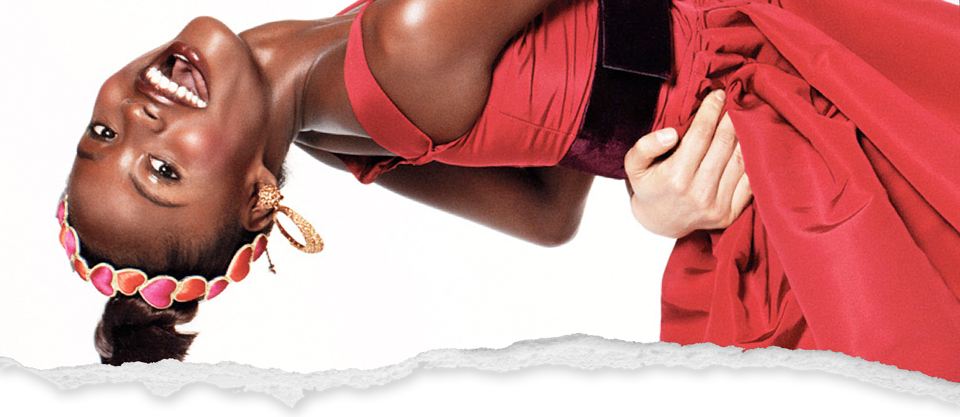
A Caribbean model contest launched Palmer’s career in 2010, and at age 17 she signed an exclusive contract with Trump Model Management in January 2011. Department of Labor records show she received approval to work in the United States beginning in October 2011. Yet according to a financial statement filed as evidence in her case, Palmer started working in the United States nine months before this authorization was granted. Her financial records list a January 22, 2011, job for Condé Nast, when she posed for a Teen Vogue spread featuring the cast of Glee. (The shoot took place at Milk Studios in Los Angeles.)
“That whole period, from January to September, was not authorized,” said Pankaj Malik, a partner at New York-based Ballon, Stoll, Bader & Nadler who has worked on immigration issues for over two decades and who reviewed Palmer’s case for Mother Jones. “You can’t do any of that. It’s so not allowed.”
Trump has taken an active role at Trump Model Management from its founding. He has personally signed models who have participated in his Miss Universe and Miss USA competitions, where his agency staff appeared as judges. Melania Trump was a Trump model for a brief period after meeting her future husband in the late 1990s.
The agency is a particular point of pride for Trump, who has built his brand around glitz and glamour. “True Trumpologists know the model agency is only a tiny part of Trumpland financially,” the New York Sun wrote in 2004. “But his agency best evokes a big Trump theme—sex sells.” Trump has often cross-pollinated his other business ventures with fashion models and has used them as veritable set pieces when he rolls out new products. Trump models, including Blais, appeared on The Apprentice—and they flanked him at the 2004 launch of his Parker Brothers board game, TRUMP.
Part of Blais’ job, she said, was to serve as eye candy at Trump-branded events. Recalling the first time she met the mogul, she said, “I had to go to the Trump Vodka opening.” It was a glitzy 2006 gala at Trump Tower where Busta Rhymes performed, and Trump unveiled his (soon-to-be-defunct) line of vodka. “It was part of my duty to go and be seen and to be photographed and meet Donald Trump and shake his hand,” she remembered.
Trump made a strong impression on her that night. “I knew that I was a model and there was objectification in the job, but this was another level,” she said. Blais left Trump Model Management the year after the Trump Vodka gala, feeling that she had been exploited and shortchanged by the agency.
Kate, who went on to have a successful career with another agency, also parted ways with Trump’s company in disgust. “My overall experience was not a very good one,” she said. “I left with a bad taste in my mouth. I didn’t like the agency. I didn’t like where they had us living. Honestly, I felt ripped off.”
These days, Kate said, she believes that Trump has been fooling American voters with his anti-immigrant rhetoric, given that his own agency had engaged in the practices he has denounced. “He doesn’t like the face of a Mexican or a Muslim,” she said, “but because these [models] are beautiful girls, it’s okay? He’s such a hypocrite.”
